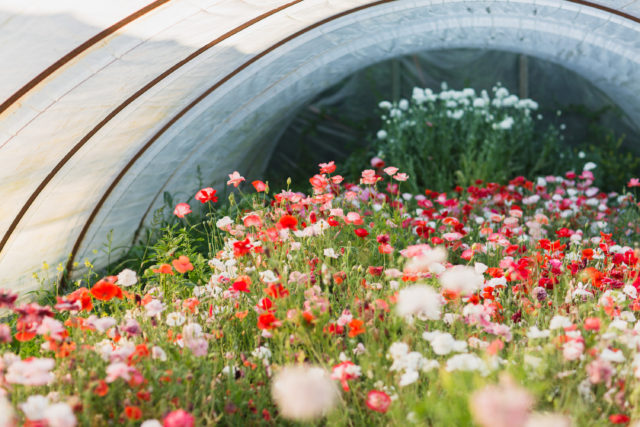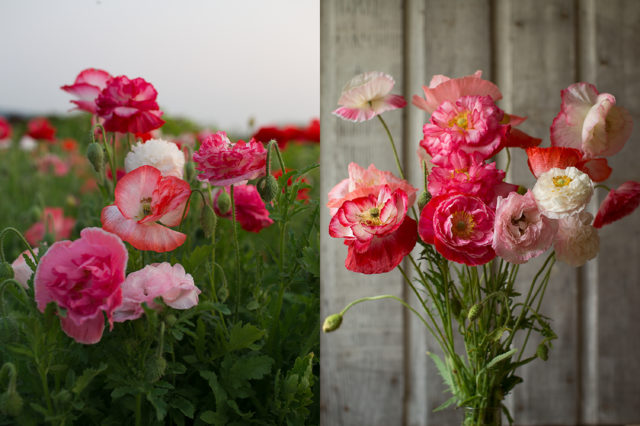When it comes to poppies, there always seems to be a great deal of confusion surrounding the different types, their growing needs, and whether they can be used for flower arranging.
I thought it might be helpful to break down the four types of seed-grown poppies that are most commonly grown for cut flowers and explain what makes them different and special.
 Iceland poppies (Papaver nudicaule)
Iceland poppies (Papaver nudicaule)
Iceland poppies are technically considered a perennial and can survive cold winter temperatures, but because they don’t handle heat and insects very well, they are typically grown as hardy annuals or biennials by flower farmers.
This particular flower requires a good deal of care when started from seed because it is slow to germinate and the seeds are as tiny as grains of sand.
 When starting seeds, it is imperative that you take great care and barely cover them with the finest dusting of vermiculite or sand. For the first few weeks, bottom-water by setting your seed trays in 1 in (2.5 cm) of standing water and letting them wick up the moisture from below. This will ensure that you don’t accidentally wash away the babies with a powerful overhead spray.
When starting seeds, it is imperative that you take great care and barely cover them with the finest dusting of vermiculite or sand. For the first few weeks, bottom-water by setting your seed trays in 1 in (2.5 cm) of standing water and letting them wick up the moisture from below. This will ensure that you don’t accidentally wash away the babies with a powerful overhead spray.
Seed flats should be kept in a warm room or on heat mats around 70ºF (21ºC) until the tiny seedlings emerge and develop at least 2 sets of leaves. I typically start seeds about 8 weeks before transplanting them into the ground.
Seedlings are slow to start and often stall out around the time they need to be transplanted. If left in the trays too long, they will fail to thrive.

 Even though plants seem too tiny and delicate to be planted into the soil, it’s important that you don’t let them sit in their trays any longer than 10 weeks. Once plants are in the ground, they will explode with new growth and are typically in full flower about 6 weeks after transplanting. Even though they seem weak, they have a lot of hidden vigor.
Even though plants seem too tiny and delicate to be planted into the soil, it’s important that you don’t let them sit in their trays any longer than 10 weeks. Once plants are in the ground, they will explode with new growth and are typically in full flower about 6 weeks after transplanting. Even though they seem weak, they have a lot of hidden vigor.
The number one reason people fail when it comes to Iceland poppies is that they don’t approach their seed sowing with enough care. This particular crop cannot be direct-seeded and must be started in trays and transplanted into good growing ground when the time is right. This is not a beginner crop.
 Depending on where you live, you can sow them in late summer and transplant them out in early fall to overwinter and flower in the spring. If you are unable to fall sow, seeds should be started no later than mid-February so flowers will be blooming before the heat of summer arrives.
Depending on where you live, you can sow them in late summer and transplant them out in early fall to overwinter and flower in the spring. If you are unable to fall sow, seeds should be started no later than mid-February so flowers will be blooming before the heat of summer arrives.
We have successfully grown Iceland poppies in hoop houses and out in the field. I prefer to grow them under cover whenever possible because they flower up to 6 weeks earlier than those planted in the field, and the delicate flowers are protected.

 Once flowers start to bloom, it can be a full-time job just to keep them picked. The best stage to harvest Iceland poppies is when the buds are just starting to crack open and the tiniest sliver of color can be seen. This is called cracking bud stage.
Once flowers start to bloom, it can be a full-time job just to keep them picked. The best stage to harvest Iceland poppies is when the buds are just starting to crack open and the tiniest sliver of color can be seen. This is called cracking bud stage.


 Iceland poppies have a surprisingly long vase life, up to a week if picked at the proper stage and treated.
Iceland poppies have a surprisingly long vase life, up to a week if picked at the proper stage and treated.
Shortly after harvest, use an open flame or boiling water to sear the stem ends for 7 to 10 seconds and place in water with flower food.
 Breadseed poppies (Papaver species)
Breadseed poppies (Papaver species)
Of all the poppies, the breadseed varieties are by far the easiest to grow. While the cut flowers aren’t particularly long lasting, persisting just 2 to 3 days in the vase, they make a wonderful addition to the garden, leaving behind the most beautiful gray- or blue-green decorative seedpods that can be used either fresh or dried.
If you want to attempt to use the flowers in arrangements, harvest when they are only half-open and sear the bottom ends in boiling water for 7 to 10 seconds. I have tried more times than I’d like to count to get these beauties to last longer, without any luck. If you have any other tricks, I’d love to hear them in the comments below!
 Breadseed poppies resent transplanting and do best when direct-sown. You can plant them directly into the garden as soon as the soil can be worked in the spring. Keep in mind that slugs love them, so you’ll need to monitor growing plants closely.
Breadseed poppies resent transplanting and do best when direct-sown. You can plant them directly into the garden as soon as the soil can be worked in the spring. Keep in mind that slugs love them, so you’ll need to monitor growing plants closely.
One of my favorite things about breadseed poppies is that they self-seed freely. Once you grow them, you will forever have them popping up around your garden.


 To save your own seed, pick the pods when they are starting to turn from green to brown or when the little vents around the crown open. I gather bunches of ripe pods, cover them with a paper grocery sack, and turn them upside down to dry in the garage for a few weeks. As the pods and seeds ripen, the seeds will fall into the bag and can be stored away for years to come.
To save your own seed, pick the pods when they are starting to turn from green to brown or when the little vents around the crown open. I gather bunches of ripe pods, cover them with a paper grocery sack, and turn them upside down to dry in the garage for a few weeks. As the pods and seeds ripen, the seeds will fall into the bag and can be stored away for years to come.
Little envelopes of homegrown seed make great gifts!
 Shirley poppies (Papaver rhoeas)
Shirley poppies (Papaver rhoeas)
Next to breadseed poppies, Shirley poppies are the easiest to grow. One plant will produce flower heads for up to 6 glorious weeks, and as each blossom fades it leaves behind the most beautiful miniature seedpods that make amazing additions to boutonnieres and dried creations.
 While individual flowers are short lived—lasting 3 to 4 days if stem ends are seared for 7 to 10 seconds in boiling water—it’s important to harvest blooms just as they are opening and before the bees find them. Unlike other poppy varieties, Shirley poppies produce clouds of dusty pollen, so if you have allergies, take care.
While individual flowers are short lived—lasting 3 to 4 days if stem ends are seared for 7 to 10 seconds in boiling water—it’s important to harvest blooms just as they are opening and before the bees find them. Unlike other poppy varieties, Shirley poppies produce clouds of dusty pollen, so if you have allergies, take care.
I love using their tissue paper-like blooms in arrangements that don’t need to last super long, including wedding centerpieces and bridal bouquets.
Plants are vigorous and free-flowering. Of all the flower varieties we grow, none is more loved by the bees than Shirley poppies. Standing next to a row of these flowers in full bloom with the bees working through the patch is a sight to behold.

 Shirley poppies resent transplanting and are best direct-sown. They can be planted into the garden as soon as the soil can be worked in the spring.
Shirley poppies resent transplanting and are best direct-sown. They can be planted into the garden as soon as the soil can be worked in the spring.
If you are starting them indoors, just be sure to take extra care when transplanting them out, and don’t disturb the roots too much. Shirley poppies will vigorously self-seed if pods are left on the plant. If you don’t want them as a permanent resident, don’t let them go to seed.
 California poppies (Eschscholzia californica)
California poppies (Eschscholzia californica)
While not actually poppies at all, California poppies are a versatile, easy-to-grow, drought-tolerant group of plants that bloom all summer long. They are well suited to small spaces and can either be direct-seeded or started indoors and planted out as soon as the weather warms in the spring.
Like other poppies, these beauties self-seed and will pop up everywhere, even in the cracks of the pavement.
In addition to the bright orange native variety that grows wild throughout the southern and western United States, there are a handful of new cultivars that are as beautiful as they are hardworking.
 These low-growing plants flower over an incredibly long period of time. California poppies are well suited to the front of the border and are great in containers if space is limited. One sowing will bloom all summer long.
These low-growing plants flower over an incredibly long period of time. California poppies are well suited to the front of the border and are great in containers if space is limited. One sowing will bloom all summer long.
For cut flowers, harvest when the blooms are in colored bud stage. Individual flowers don’t last super long, only 3 to 4 days, but as they fade and drop their petals, the new buds on the stem will pop open, giving you a week’s worth of flowers from one stem. These poppies do not require any searing to last this long in the vase.
 Depending on how much patience you have and how you plan to use them, you’re sure to find a poppy that meets your needs. No cutting garden is complete without them!
Depending on how much patience you have and how you plan to use them, you’re sure to find a poppy that meets your needs. No cutting garden is complete without them!
Do you grow poppies? Do you have a favorite variety? Please take a minute and leave a comment below about your experience growing poppies.
Please note: If your comment doesn’t show up right away, sit tight; we have a spam filter that requires us to approve comments before they are published.







Anu on
Question – I planted the pink Breadseed variety from Floret about 4 years back. While it does self seed beautifully, there are several plants now that have white or pink, single petal flowers. Curious how this happened given there are no other poppies around. They are still quite pretty.